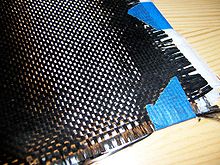
| Part of a series on |
| Fiber |
|---|
 |
| Natural fibers |
| Human-made fibers |
Carbon fibers or carbon fibres (alternatively CF, graphite fiber or graphite fibre) are fibers about 5 to 10 micrometers (0.00020–0.00039 in) in diameter and composed mostly of carbon atoms.[1] Carbon fibers have several advantages: high stiffness, high tensile strength, high strength to weight ratio, high chemical resistance, high-temperature tolerance, and low thermal expansion.[2] These properties have made carbon fiber very popular in aerospace, civil engineering, military, motorsports, and other competition sports.[3] However, they are relatively expensive compared to similar fibers, such as glass fiber, basalt fibers, or plastic fibers.[4]
To produce a carbon fiber, the carbon atoms are bonded together in crystals that are more or less aligned parallel to the fiber's long axis as the crystal alignment gives the fiber a high strength-to-volume ratio (in other words, it is strong for its size). Several thousand carbon fibers are bundled together to form a tow, which may be used by itself or woven into a fabric.
Carbon fibers are usually combined with other materials to form a composite. For example, when permeated with a plastic resin and baked, it forms carbon-fiber-reinforced polymer (often referred to as carbon fiber), which has a very high strength-to-weight ratio and is extremely rigid although somewhat brittle. Carbon fibers are also composited with other materials, such as graphite, to form reinforced carbon-carbon composites, which have a very high heat tolerance.
Carbon fiber-reinforced materials are used to make aircraft and spacecraft parts, racing car bodies, golf club shafts, bicycle frames, fishing rods, automobile springs, sailboat masts, and many other components where light weight and high strength are needed.
- ^ Chaudhary, Anisha; Gupta, Vinay; Teotia, Satish; Nimanpure, Subhash; Rajak, Dipen K. (2021-01-01), "Electromagnetic Shielding Capabilities of Metal Matrix Composites", in Brabazon, Dermot (ed.), Encyclopedia of Materials: Composites, Oxford: Elsevier, pp. 428–441, ISBN 978-0-12-819731-8, retrieved 2022-02-14
- ^ Bhatt, Pooja (2017). Carbon Fibres: Production, Properties and Potential Use (Thesis). Archived from the original on 2021-04-30. Retrieved 2021-07-25.
- ^ "What is the Carbon Fiber Plate in Shoes? Let's Make It All Clear Here!". clarco.com. 19 November 2022. Retrieved 2022-11-19.
- ^ Hasiotis, Theodoros; Badogiannis, Efstratios; Tsouvalis, Nicolaos Georgios (2011). "Application of Ultrasonic C-Scan Techniques for Tracing Defects in Laminated Composite Materials". Strojniški vestnik – Journal of Mechanical Engineering. 57 (3): 192–203. doi:10.5545/sv-jme.2010.170. ISSN 2536-3948. Retrieved 2023-02-21.